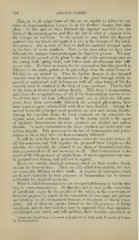Page 748 - My FlipBook
P. 748
758 DENTAL CABIES.
Here, as in all other forms of life, we are unable to follow by any
form of experimentation known to us the further changes that take
place. In the seed we have followed the digested material into the
ducts of the growing germ, and they are lost in what we suppose to be
the changes of nutrition. In the animal we may follow the digested
material into the blood, and again it is lost in the changes of the nutri-
tive process. But in both of these we find the material returned again
in the form of waste products. Now, in the yeast-plant we have also
followed the changes consequent upon the digestive process. We may
also watch the growth of the plant by the aid of the microscope, and see
the young buds si)ring forth, and follow their development into full-
grown cells. AVe have no reason for the supposition that this growth is
different in the main points of its physiology from the other forms of
life that we see around lis. Then the further changes in the digested
material must be those of the nutrition of the plant through which its
growth is maintained, and in harmony with all other forms of life the
material must be returned in the form of waste products. This we find
in the form of alcohol and carbon dioxide. This, then, is fermentation,
and forms the recognized type of all of the fermentations known to us.
In all that have yet been sufficiently made out, in which the life-pro-
cesses have been successfully followed, the essential phenomena have
been found to agree substantially with those here detailed. Among the
animal forms the principal waste products are urea and carbon dioxide.
Among the vegetable forms the waste products are the alkaloids, the
organic acids, and carbon dioxide. In the torula, which is the agent
of alcoholic fermentation, the waste products are alcohol and carbon
dioxide. In acetic fermentation the waste products are acetic acid and
carbon dioxide. This proves to be the law of fermentation and putre-
faction so far as they have yet been accurately followed.'
It will be seen that these propositions cover the essential factors of
all life-processes, and link together the proposed three kingdoms (the
mici'obe, the vegetable, the animal) in one chain of functional activities
that are common to all and necessary to all. That fermentation is the
result of the life-processes of certain forms of micro-organisms may now
be accepted as a truism, and will not be argued.
There are certain chemical processes which in their results closely
imitate the fermentations. These are still called fermentation, but they
are essentially different in their mode. A number of substances which
are formed naturally by true processes of fermentation can be formed
artificially by chemical processes.
Wliat is called fermentation by an unorganized ferment is but the first
step in a true fermentation. In digestion this is seen in the conversion
of starch into sugar by the ptyalin of the saliva, in the conversion of
flesh into peptone by pepsin, in the conversion of cane-sugar into glucose
and Icvulose by the unorganized ferment of the torula or vinous yeast-
plant. All of these are agents formed in the life-processes of living
organisms, and the fact that they may l)e separated from that organism,
precipitated, and dried, and will j)erfi)rm their function afterward on
^ I have devel()i)etl tliese laws more at length in (he little work Formation nf Poisons
by Jlicro-orf/unismn.


